This recipe is for a 10 to 14 pound turkey. I will update for larger turkeys later. (I rushed this recipe out after roasting a turkey in the wee hours of the morning, so everyone could get a head start on planning for their turkey dinner. I'll correct any mistakes I may have made after the weekend.)
Related Articles
 Now that the turkey is ready to go, preheat your oven to 400°F. Chop up two medium onions, five carrots, and two celery ribs. Also melt 3 tablespoons butter and set aside 2 tablespoons dried thyme (or two sprigs of fresh thyme). Quantity and even chopping is not that important for this recipe, so feel free to prepare these steps quickly to save time.
Now that the turkey is ready to go, preheat your oven to 400°F. Chop up two medium onions, five carrots, and two celery ribs. Also melt 3 tablespoons butter and set aside 2 tablespoons dried thyme (or two sprigs of fresh thyme). Quantity and even chopping is not that important for this recipe, so feel free to prepare these steps quickly to save time.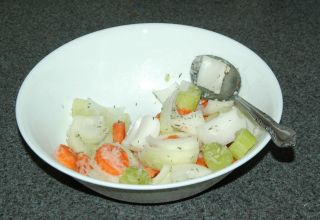 From the chopped vegetables, take about half an onion, a carrot, and a half celery rib and combine them with about 1 tsp. thyme and a tablespoon of melted butter. Mix them until evenly distributed.
From the chopped vegetables, take about half an onion, a carrot, and a half celery rib and combine them with about 1 tsp. thyme and a tablespoon of melted butter. Mix them until evenly distributed.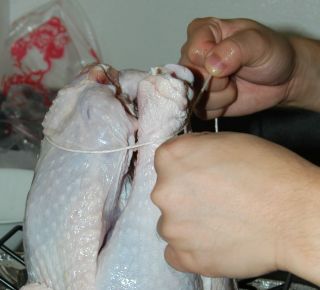 Throw the prepared vegetables (from the previous step) inside the turkey. Now, tie up the turkey's wings and legs so they will cook evenly. Take a 5 foot (1.5 m) long piece of kitchen twine and tie the drumsticks together as shown.
Throw the prepared vegetables (from the previous step) inside the turkey. Now, tie up the turkey's wings and legs so they will cook evenly. Take a 5 foot (1.5 m) long piece of kitchen twine and tie the drumsticks together as shown.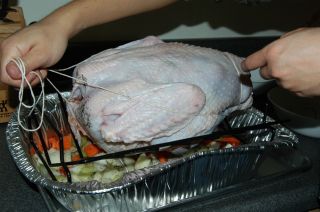 Loop the twine around the turkey and over the wings.
Loop the twine around the turkey and over the wings. At the head of the turkey, tie a knot over the flap of skin to hold everything in place.
At the head of the turkey, tie a knot over the flap of skin to hold everything in place.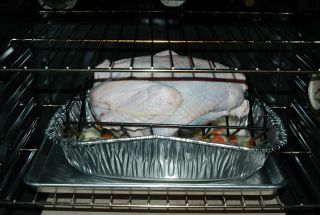 Place the rest of vegetables and thyme in a roasting pan. If you don't have a roasting pan, you can use a disposable aluminum foil roasting pan from the supermarket. Pour one cup water into the pan and place a V Rack into the pan. Brush breast side of the turkey with butter. Place the turkey on the V rack with the breast side facing down. Brush the back with butter. Place in a 400°F oven.
Place the rest of vegetables and thyme in a roasting pan. If you don't have a roasting pan, you can use a disposable aluminum foil roasting pan from the supermarket. Pour one cup water into the pan and place a V Rack into the pan. Brush breast side of the turkey with butter. Place the turkey on the V rack with the breast side facing down. Brush the back with butter. Place in a 400°F oven.We're roasting this turkey upside down (usually turkeys are roasted breast up) to cook the breasts at a slower rate. Starting breast side down, gives the legs a head start on cooking. This is desirable because drumsticks and thighs need to be cooked to a higher temperature (about 170°F) in order to remove any trace of pink flesh. The breasts would become very dry and unpalatable if cooked to temperatures as high as the legs.
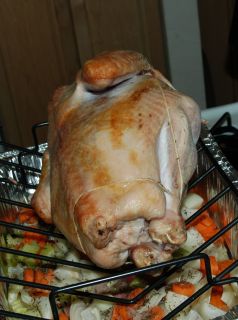 After 45 minutes, remove the turkey from the oven and baste it with the juices from the roasting pan. I've tried to come up with an easy way to do this without a turkey baster, but I was unable to. Use a turkey baster to reach in between the rungs of the rack and suck up some juices and squirt it over the turkey. Then rotate the turkey onto its side (with a leg sticking up) and brush some more butter on. Return to oven for fifteen more minutes, then baste again and rotate onto other side. Roast for fifteen minutes. Roasting the turkey on its sides lets the sides brown (for better presentation). If you don't care about even browning, you can skip these two rotations and just prolong the breast down roasting by thirty minutes. (You may want to baste once after the 45 minute mark, though.)
After 45 minutes, remove the turkey from the oven and baste it with the juices from the roasting pan. I've tried to come up with an easy way to do this without a turkey baster, but I was unable to. Use a turkey baster to reach in between the rungs of the rack and suck up some juices and squirt it over the turkey. Then rotate the turkey onto its side (with a leg sticking up) and brush some more butter on. Return to oven for fifteen more minutes, then baste again and rotate onto other side. Roast for fifteen minutes. Roasting the turkey on its sides lets the sides brown (for better presentation). If you don't care about even browning, you can skip these two rotations and just prolong the breast down roasting by thirty minutes. (You may want to baste once after the 45 minute mark, though.)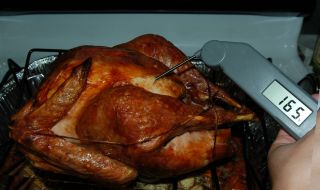 Now, rotate the turkey so it is breast side up. Baste again and brush on the remaining butter. Roast for thirty more minutes and then start to check the temperature every ten minutes. The turkey is done when an instant read thermometer thrust into the breast reads 165°F.
Now, rotate the turkey so it is breast side up. Baste again and brush on the remaining butter. Roast for thirty more minutes and then start to check the temperature every ten minutes. The turkey is done when an instant read thermometer thrust into the breast reads 165°F.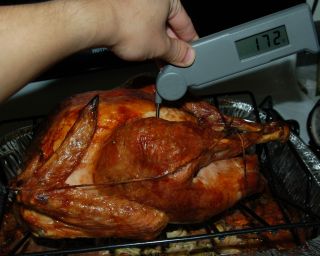 The deepest part of the thigh should read between 170°F to 175°F. Remember that the only way to know if your turkey is both safe to eat and not overcooked is with an accurate digital thermometer.
The deepest part of the thigh should read between 170°F to 175°F. Remember that the only way to know if your turkey is both safe to eat and not overcooked is with an accurate digital thermometer. 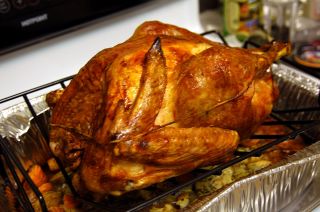 Remove the turkey and allow it to rest for twenty or thirty minutes.
Remove the turkey and allow it to rest for twenty or thirty minutes.Carving (a quick synopsis)
Place the turkey breast side up on a carving board.
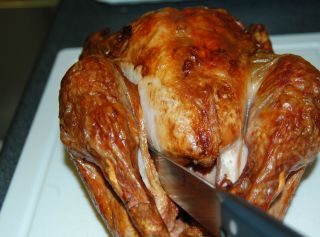 Cut the skin between the thigh and the body of the turkey. Cut in while using a fork to peel the leg away from the body.
Cut the skin between the thigh and the body of the turkey. Cut in while using a fork to peel the leg away from the body.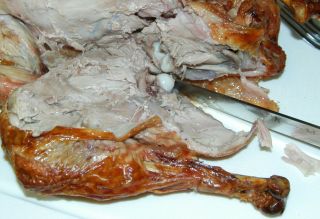 Cut through the joint to remove the thigh and drumstick. Place the leg flat on a cutting board. Separate the thigh from the drumstick by cutting through the joint. Cut the meat off the sides of the thigh bone. Cut the meat off the drumstick. Repeat for the other leg.
Cut through the joint to remove the thigh and drumstick. Place the leg flat on a cutting board. Separate the thigh from the drumstick by cutting through the joint. Cut the meat off the sides of the thigh bone. Cut the meat off the drumstick. Repeat for the other leg. Remove the wings by pulling them away from the body and thrusting a knife through the joint to sever. Once all the limbs have been removed, cut through the skin along the keel bone.
Remove the wings by pulling them away from the body and thrusting a knife through the joint to sever. Once all the limbs have been removed, cut through the skin along the keel bone. Angle the blade out a little and cut down along the bone to remove the breast. Do the same to the other side.
Angle the blade out a little and cut down along the bone to remove the breast. Do the same to the other side.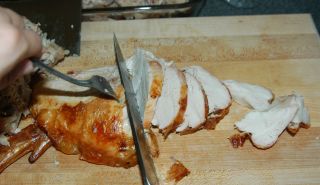 Cut the breast meat against the grain into thin slices.
Cut the breast meat against the grain into thin slices.Arrange however you like and serve with those accompaniments that are traditional to your family. (For a nice gravy that goes with this turkey, see Test Recipes: Giblet Pan Gravy.)
Classic Roast Turkey (serves 14)
Prepared Turkey
| Preheat oven to 400°F (205°C) | |||||
| 12 lb. turkey, thawed or fresh | brine | stuff | brush on both sides | place on V-rack in pan | roast until breast 165°F (74°C), thigh 170°F (77°C) |
| 1/2 onion, chopped | mix | ||||
| 1 carrot, chopped | |||||
| 1/2 celery rib, chopped | |||||
| 1 tsp. dried thyme | |||||
| 1 Tbs. butter, melted | |||||
| 1 Tbs. butter, melted | |||||
| 1-1/2 onion, chopped | place in roasting pan | ||||
| 4 carrots, chopped | |||||
| 1-1/2 celery rib, chopped | |||||
| 5 tsp. dried thyme | |||||
| 1 cup water | |||||
Roasting table
| Time | 0:15 | 0:30 | 0:45 | 1:00 | 1:15 | 1:30 | 1:45 | ||||||||
| Position | breast down | leg up | other leg up | breast up | |||||||||||
| Action | baste, rotate, butter | baste, rotate, butter | baste, rotate, butter | ||||||||||||
Related Articles

I baste not for juiciness (that's guaranteed by the brining and rotations), but for flavor. Without basting, the skin and thin layer of surface meat is not flavorful enough for me. I found that not using the turkey drippings and just using butter creates too much butter flavor (although the skin becomes a wonderful color and and smells great). Using both butter and turkey drippings makes the outer layer of the turkey have excellent flavoring and color.
I should also emphasize that you should take the turkey out of the oven before basting it. No matter how fast you are at basting and rotating, it's much better to have the turkey out of the oven (and the oven door closed, of course) while doing this operation.
If you really want to baste, try cutting a slit through the skin lengthwise along the top of the breast, it gives the basting juices somewere to go.
I notice you have a bread baking stone in the bottom of the oven, and this will go a long way to maintaining thermal energy - as was suggested above via the method of unglazed tiles.
The basting question os a tough one. I made three turkeys last year by the Alton Brown method and the meat was as good as I have ever tasted. I agree the skin (particularly the area under the foil breastplate) did leave a little to be desired. It never got to that "crackling good" stage. The breast plate method does save you from having to do turkey calisthenics (the flip-flop).
If you do not have a V rack you can use a tin foil rope - as outlined by AB.
Stuffing the turkey is, of course, verboten.
Just a question on brining. Do I just put salt and water and that's it? Do I need to bring it to a boil first and then cool it?
Also, is alumnium a "nonreactive" container? Or would I need to buy a huge plastic container?
Also, Aluminium is reactive, plastic is probably best, however there are alternatives, but for some reason I'm drawing a blank as to what would fit a giant turkey..
Stuffing the bird is verboten? Why?
Cook the stuffing separately; if it needs to be in the turkey at the table then stuff it in while you're in the kitchen.
I use stainless steel or plastic for brining turkeys. A large plastic tupperware bin placed in the refrigerator with brining solution for a couple hours before brining the turkey. Or, you can use a portable ice chest filled with brining solution and packets of frozen ice in bags if your containers don't fit in your fridge.
Glass is also nonreactive, but I don't know if anyone makes a glass container large enough for a decent sized turkey. It'll be really heavy too.
Thanks for pointing out the typo (quarts vs. gallons). I fixed it.
Thank you.
Any suggestions specific to this appliance would be appreciated?
I generally prepare a turkey or turkey breasts every couple of months or so and have found that a 5-gallon paint-bucket works wonderfully. They can be found in almost any hardware or home-improvement store for under $10. And they come with tight-fitting lids which work very well when transporting the brined bird. These will handle a 10-18 lb bird with plenty of room for the necessary ice (since this will not fit into most people's refrigerator).
Happy Thanksgiving everyone!
I am on my 2nd brined and grilled bird. A paint bucket from the hardware store does an excellent job. A different color than the buckets used for sample collection so you don't get them mixed up.
Ice bags are a no-no. Have you read what they contain? I know dilution is solution but I really don't want to take chances on poisonng my bird.
One last word on food safety, The basic mantra of the food scientist, Life ( campy, salmonella, etc. ) begins at 40 F and ends at 16O F. Ice and a lid will maintain this overnite. Remember to allow for the extra volume when preparing brine.
Starting with a frozen bird (the kind you get for free from the supermarket around Thanksgiving), make the brine and pour it into your bucket. Remove the turkey from the bag and submerge it in the brine. Then add ice and your lid.
Put this somewhere like a garage (cool, but not cold) 48 hours before you want to cook the bird. Halfway through the brining, flip the bird.
You should have a gently thawed bird that's chock full of briney goodness.
Did I misread something?
It's good that the turkey turned out fine... now to salvage the juices. If you have a large pan (one big enough for a 25 pound or larger turkey) then you'll probably need more than 1 cup of water to start in the pan. (The larger pan allows the water to spread out thinly and it will evaporate faster.) The exact quantity of water is not that important, just don't pour in a gallon or something. While checking on the turkey, if the water seems to be almost evaporated, add another cup (or more if you have a larger pan), to keep the drippings from burning. Don't worry too much about the liquid quantity even if almost all the water has evaporated, you'll be deglazing the pan for the gravy later. Just don't let it burn.
http://www.samcooks.com/flavor/turkey%20talk.htm
can anyone confirm this? I prepared a fresh turkey a few months ago (not brined), and it was fabulous! A couple of days ago i brined a utility grade turkey and it was dry and tough ( i also think i didnt defrost it long enough).
before i spend money on a frozen bird again, i will look for a fresh one.
I brine the turkey in a canner. (In case you aren't familiar with canning, a canner is a big metal pot, about 15" high and 18" in diameter--I'm estimating--used to sterilize and vacuum pack jars. It's made of enamel coated steel.) It does not fit in the refrigerator, so in the winter, I leave the canner outdoors out of the sun with the lid taped on.
During warmer months, I buy just a turkey breast and brine it in a big
stainless steel pot that does fit in the refrigerator.
I roast the turkey in a Reynolds oven bag. It keeps the bird moist and seems to reduce cooking time.
One way to give a bird a tan is to baste it with balsamic vinegar 15 minutes before it's done. It does not affect the flavor.
Or I just roast a duck. (This is what I serve for Thanksgiving when it's held at my house.) It's more expensive, but it's so moist and tasty that it needs no special treatment except for the balsamic vinegar.
i do the same with a roasted chicken, of course.
btw... i'm a newbie... nice ya got here! :)
Also I loosen the skin over the breast and insert some the fat from around the cavity between the skin and the breast meat and it helps keep the breast moist. You can also insert herbed butter or herb the chunks of turkey fat.
I have used the rotation method before on a slightly smaller bird and found it very awkward to turn. Any tips?
I am going to make the turkey unstuffed this year and will remove the boniest part of the wing to place on top of my stuffing for a more in-the-bird taste. I'll let you know how that works.
This is the substance that allows the family to do world-class beached whale imitations.
Some how those charged with the clean-up seem to be immune to its effects.
http://www.psychologytoday.com/articles/pto-20031006-000001.html
Take a look at:
http://www.globalgourmet.com/food/kgk/2000/1100/kgk111800.html
Sandra in Nevada
Brining not only adds flavor to the turkey meat, but it "loosens up" the protein so it can hold more water during the cooking process. The end result is that you have a juicier roast.
For more information, see Kitchen Notes: Brining
thanks
marty in Nevada
Nancy From Arizona
I also admit that I haven't cooked a turkey like that in a while since I started using Mr. Ronco's Showtime™ Professional Rotisserie. Shake some cajun seasoning on the skin and you will have a fabulous bird. It is on a par with deep frying in peanut oil, without the mess involved with that process. Mr. Ronco also does a fabulous job with those big 8-10 pound chickens, and you get more wings and legs for the hungry troops than a single 14 pound turkey.
(Am not a spokesperspon for WS, but I simply thought you might want to see it, after reading that you've been using all kinds of things to contain turkeys in brine).
If someone uses one, please post your experience!! (I'd love to give it a try, except I live in Mexico and WS doesn't deliver here...).
Here is the link for the Brining Bags http://www.williams-sonoma.com/products/cw248/index.cfm?&bnrid=3101528&am...=on
Huge CFE fan in Mexico
Now you can find turkey brining bags in stores. Williams-Sonoma sells two large zip lock brining bags for $10. Otherwise I would suggest lining the container with a food safe plastic bag. I am all for minimizing consumption of leached chemicals.
Just my opinion, but I do not like brined turkeys at all. We tried it two years ago and said we would never do it again. I really do not like undone appearing turkey that is very moist, it always tastes raw to me. But that is just my personal preference. GOod helps here for roasting. Thanks. Moey
Any thoughts on time? Oh, and yes, I did measure the oven, this time~ been there, done that one.
Any help would be greatly appreciated.
Anyways, thanks for all the Grassroots tips on the roasting of Turkeys. I am having a few friends over tonight for some turkey, and needed some ideas. After reading this thread, it made me realize something...
I forgot the aluminum foil...
Thanks for the ideas.
Last year, I put a big roasting bag in my sink, and loaded the bird into it. Once it was settled, I poured in the brine, squeezed all the air bubbles out, and sealed the bag. I packed ice around the whole thing and let it sit the whole morning, then roasted it like usual, and it came out great. Good luck with all your turkeys! -K3
I hope every one has a great Turkey Feast!!
I've also tried cooking upside down and turning after about 45 minutes but you'll end up with a very funny bumpy looking turkey as the stuffing compressing under the v grate bars. But if you don't care about looks this is also possibility.
I use one of those turkey roasting bags, place the turkey in, pour in the cold brine with some ice cubes and twist it closed. Then I place it in its roasting pan in the fridge.
This year I am making my turkey at my grandparents, 7 hours away. I'm going to try to drive and brine. I think an ice chest filled with ice and the turkey bag snug in the middle will work great.
Great in the brine: fresh rosemary sprigs, sliced oranges and peppercorns.
For my first turkey I made herbed olive oil with fresh herbs and orange zest and juice and rubbed it between the skin and meat. I think that made a big difference in the flavor.
Good luck with your special turkey!
Thanks, and I hope you all have a great day!
Confused in California
And hey, don't knock Costco on their meat department. I live in Virginia. I don't think there's a decent butcher shop in the entire state that doesn't cost a fortune. The meat at the Costco here is better than in the grocery stores.
In one of her last books, Julia Child herself gave a shout out to Costco meat! I'm thrilled there's one minutes away from my home.
Good luck with that bird!
As long as the turkey is stored at temperatures greater than 26°F (-3°C), it can be labeled fresh. For more info on buying turkeys, see Kitchen Notes: Buying Whole Turkeys
love the site.
i was planning to follow a variation of your recipe, and noticed a special caveat you had about brining with special "pre-treated" birds. i looked, and it turns out i bought a 20lb norbest turkey that had been pre-basted with turkey broth or something along those lines. i think this includes sodium.
can i still brine the bird? you wrote to decrease the level of salt in the brine solution but how much is too much?
i'm afraid of making an overly salty bird. would it just be safer to skip brining in this case? or can one "brine" with just aromatics and peppercorns and star anise and such with no salt? seems to defeat the purpose.
Subject: old timey reciepe
Whatever happened to the old timey way of cooking the bird slowly and for a long time? I know it is not recomended but the turkey I am going to have at Thanksgiving will normally be cooked for around 12 -15 hrs at 200 - 225 and will not only have an internal temp of at least 185 but will also be the moistest one you have ever eaten. Typically it goes in at around 9 in the evening and comes out at noon next day. No one has ever gotten sick. Plus as an engineer I appreciate the ease of preparation - put it in the oven and dont mess with it.
Then you've been damn lucky. I'll take the health of my family over ease of preparation anyday.
can i still brine the bird? you wrote to decrease the level of salt in the brine solution but how much is too much?
This is a bit tricky since without previous experience with that brand of turkey, it's really difficult to determine just how salty the bird already is. However, generally, even birds that have already been injected with salt water/broth solution can benefit from a brining. To be safe, use half the salt to water (1/2 cup to 1 gallon ratio). This will reduce the salt and the rate at which the brine affects the turkey, but will still make a difference.
I just realised I bought a "butterball" turkey that is infused with 7% solution. Have you use this brand before and can I also use the above salt to water ratio too? And is it advisable to use a turkey oven bag? Thanks.
Even though the Butterball comes infused with a 7% solution, it can still benefit from a brine. Use the reduced concentration brine: 1/2 cup table salt to 1 gallon ratio.
A turkey bag is a convenient way to prepare a turkey, but you won't be able to use the recipe as written above.
Last year I cooked it at 375F and wound up having to use foil to get an even doneness, but the turkey came out very juicy with crisp skin. I dusted the turkey with Tony Chaceres and sprayed it with olive oil, no basting while cooking. Everyone agreed it was the best they had ever had.
This year I got a Diestel bird, which is fresh and has no antibiotics or other unatural products added. I used some leftover Jalapeno Butter Marinade, mixed with olive oil, and coated the turkey with that. I cooked it this year at 300F and did not have to use foil. The skin was not crispy, but was still very flavorful. Everyone raved about the juicyness and flavor of the meat. Everyone agreed it was even better than last year, and had no Jalapeno "heat" but just a hint of Jalapeno flavor, which was perfect.
This year I used a remote probe to measure the internal temp. Got it at Walmart for $10 and it has an alarm for when the setpoint temp is reached. This allows you to check the temp without opening the oven. A 22 pound turkey was fully cooked in 3 hours and 20 minutes at 300F in the convection oven.
I'm sold on, convection ovens, Diestel birds and Tony's marinades.
I got my Diestel bird at Whole Foods.
What does NaCl do to the plastic which could endanger someone? Just curious.
Subject: old timey reciepe
Whatever happened to the old timey way of cooking the bird slowly and for a long time? I know it is not recomended but the turkey I am going to have at Thanksgiving will normally be cooked for around 12 -15 hrs at 200 - 225 and will not only have an internal temp of at least 185 but will also be the moistest one you have ever eaten. Typically it goes in at around 9 in the evening and comes out at noon next day. No one has ever gotten sick. Plus as an engineer I appreciate the ease of preparation - put it in the oven and dont mess with it.
Then you've been damn lucky. I'll take the health of my family over ease of preparation anyday.
The fact is, it doesn't matter how you cook the bird as long as you get a final temp of 170 in white and 180 in dark meat, it will be safe to eat. I have cooked turduckens (25 lb turkey, 9 lb duck and 6 lb chicken--weights before cleaning and deboning) at 200 degrees for 20 hours, and using a final internal temp of 180, and everything was moist, tender and de-bacterialized. You don't cook food to make it sterile, you cook it to kill reasonably expected bacteria from handling and what might be in an otherwise healthy animal, and muscle tissue (that's what you eat in animals for the most part) is sterile. I don't think you would want to eat meats cooked to a final temperature of more than 212 degrees which would insure everything other than bacterial spores would be killed. To really sterilize food, you would have to cook it in a pressure cooker (a home autoclave) achieving a temperature of 250 degrees for 15 minutes. YUCK!
You can deep fry, hot smoke, roast at 300 degrees, 350, 500, then down to 350 or so or god forbid boil or microwave the turkey, but as long as the prescribed internal temps are achieved, the bird is safely cooked. Flavor and tenderness is largely the result of preparation technique. As long as you don't overcook the bird, it won't dry out.
Why not just stuff the turkey, then roast and baste it??
As a child I often saw it done this way---especially with chestnut or other suffing which would then be made into a dressing such as sage, chestnut or sausage etc.
Why not just stuff the turkey, then roast and baste it??
As a child I often saw it done this way---especially with chestnut or other suffing which would then be made into a dressing such as sage, chestnut or sausage etc.
Brining is not of any "religious value." The Kosher law requires SALTING and there is no substitute. After salting, a period of rinsing with cold water is required. The purpose of salting is to draw out any remaining blood after slaughter, liquid brine cannot do this and does not satisfy Kosher law. The purpose of brining is to partially denature and break down the protein and soften the poultry over a 12-48 hour period. It also, after a period of equilibration brings more water into the meat, making it juicier after cooking. Longer brining periods can be used. but I am told it leads to meat that is too salty tasting.
A problem with cooking a stuffed birds is that the stuffing draws water and moisture out oif the bird and also increases the necessary cooking time needed for the stuffing to reach a safe internal temperature. This extra cooking time also tends to dry out the bird.
Thanks! I love your website, and hope you continue to add more recipes!
Bill
About the earlier discussion on why people sleep after turkey - yes, turkey contains Tryptophan. This is an amino acid that your body uses to make serotonin, one of the "home-grown" chemicals that your body can synthesise to make you feel good. This can make you feel sleepy, just like drinking some wine, or having sex, can make you sleepy. I am inclined to say, though, that the AMOUNT of Christmas dinner people manage to put away, rather than the particular content of the dinner, is more likely to make them sleepy. Eating a lot turns off your body's adrenaline reactions, making you into a doughy, dopey ball of niceness, rather than the angry, powerful tower of strength you would be if you were locked outside in the snow without your turkey.
You might want to consider brining with Wild Turkey added as well. Chris Carmichael (or something like that) had a real nice recipe for turkey brined in WT on Martha Stewart's web site.
Since I didn't have any food-safe paper bags handy, my next turkey was cooked breast side down, directly on the oven rack, with a tray below to collect drippings. No brining, flipping, or basting here either. The better airflow around the bird did make it cook quite quickly to temperature, but the wings and legs ends dried up a lot. The breast (cooked down, so it had grill marks, but I don't care) was wonderful.
I always start with a salt, butter, and spice rub as well as a few broken veggies in the cavity for flavor. Both mine so far have come out as good or better than anything I remember from childhood holidays.
Oh, I had a question. I have always used frozen turkeys like Butterball and such that contain 8-10% "of a solution." I assume this is the butter juice they get injected with or something. My point is, are these birds essentially pre-brined? Will further brining simply dilute their special "solution" with your own? Having never had a brined turkey, am I simply missing something?
Brined for 4 hours using 1 cup salt per gallon of water. Covered entire bird in solution.
Pat-dried with paper towels and used a hair dryer on 'cool' setting to completely dry the bird.
Covered entire bird with salt, pepper and butter.
Put breast-down on a rack laying over a baking tray.
Basted one time after 1 hour.
Cooked at 325 F for 3.5 hours.
Cooled for 15 miutes.
Awesome turkey!! Thanks for the tips.
Anthony
Sure.
I had absolutely no idea how to cook the bird and came to this site to find out how. I came to the part in the recipe that requires brining. I did not have anything large enough to brine a bird. So I took off to Wally-World to find something and found nothing in the cooking ware section.
It was not until I went to purchase some food for my fishes that I found an inspiration as to resolve the problem of a non-reactive container for brining. I saw a display of 25 gallon(and other sized) glass aquariums for $35-40 in price.
I ended up buying a 25 gallon aquarium and using that to brine the turkey. Worked like a charm for me.
P.S. - Considering this was my first time cooking a turkey, I did very well. Whether that is due to the instructions on this website or blind beginners luck..IDK, but I do know the bird was a hit. Thank you very much Cooking For Engineers!!!
Be careful when brining a kosher bird - often they are already pretty salty and a full brining time will result in an overly salty bird. I recommend halving the brining time when using a kosher turkey.
If the holiday falls on Thursday, she had me brine the thawed turkey on Monday of the same week, in the refrigerator in a 5 gal bucket, (purchased solely for this use). As suggested, I brined the bird for 12 hours, rinsed and patted the bird dry, covered with plastic wrap and refrigerated until Tuesday.
On Wednesday, I roasted the bird, as recommended, making a wonderful looking bird, bringing the breast temperature up to 130 degrees internal temperature. Vastly undercooked, but on purpose. I let it rest to a tolerable temperature, and carved the bird off the bone into primal sections, [u:4151c61130]not slices[/u:4151c61130], (e.g., leg/thigh, each breast, etc.) Those primal sections were stored refrigerated in a covered, non-reactive pan, with turkey or chicken stock covering the lower half of the sections. At this point, as I vigorously cleaned up all of the juices and trimmings on my counter and board, I was certain I was about to kill everyone on my guest list. Please read on.
I held the bird, quasi-carved, in the refrigerator in a foil-covered stainless steel pan until Thursday. Two hours before service, I put the entire pan straight from the refrigerator into the oven, and brought the turkey up to the appropriate internal temperature. I have even crisped the skin on baking sheets during the last 30 minutes of cook time. If the white meat is done before the dark meat, you can separate them in this process. The turkey can be held like this, covered pan with lots of stock, to keep it moist and delicious. Remove from the pan and let rest as usual, then carve slices as usual. This first one was not only the best tasting and looking bird I have ever served, but I was able to enjoy my guests. I have done it that way ever since, and no one has ever been sick from the food, (I have had a few with hangovers from the pomegranate martinis though!)
I strongly recommend this process, but keep in mind that the un- or under-cooked parts must be kept properly refrigerated, and that the served product must be brought up to the appropriate internal temperature, just like always. I use Clorox wipes to clean up, but you can use a diluted bleach or other anti-bacterial agent to clean up the dangerous undercooked drippings.
I also use the undercooked carcass for stock by roasting it after the meat has been flayed from the bones. Wonderful!
As to the post from "On November 18, 2005 at 02:14 AM, an anonymous reader said...", the CIA guy; A formal cooking school is very good at teaching the mechanics of following a recipe, and thus turning out competent cooks, some of us "geeks" like to know the why, not just the how.
With a 1 cup table salt per 1 gallon water brining solution, I advocate 4 hours of brine time. Going 8 hours is a bit too salty for my taste and less doesn't seem to firm up the flesh and provide adequate moisture in the meat to not dry out during the roasting.
I've used nothing else and my bird always comes out browned, very moist, and mouth-wartering.
I baste it outside and in the cavity with a mixture of thyme, ground sage, garlic and onion powder in melted butter (NOT MARGERINE!) I then stuff it with a traditional bread stuffing and place it in the bag with 3-4 small slits in it and insert a roasting thermometer in the meaty part of the breast.
• Large turkey 18 to 22 pounds
• ½ lb butter, melted
• ½ pound bacon
• 1 stuffing
Salt
Method
1. Remove giblets, neck and excess fat from turkey cavities. Save for gravy stock. Wipe turkey inside and out with paper towels and salt. Preheat oven to 325°
2. Stuff upper and lower cavities. Pin or sew neck flap to back, sealing stuffing. Tie legs together with unwaxed kitchen string. Tuck wings under turkey. Brush turkey with half the butter. Lay bacon over breast.
3. Place turkey on a roasting rack in a roasting pan larger than the turkey, with three to four inch high sides. Baste bacon with melted butter to help prevent the foil from sticking to the bacon. Cover completely with baking paper and with foil (tuck foil over edges of pan to seal). Place pan on lowest shelf in oven and roast for 1 hour. Remove turkey from oven and baste with a little remaining butter. Re-cover securely and roast for 1 1/2 hours, basting every 30 minutes or so.
4. Remove bacon and discard. Baste turkey with pan juices. When turkey reaches 165° degrees, remove foil and roast, uncovered, for 30 minutes or until turkey is golden and just cooked through (juices should run clear when thickest part of thigh is pierced with a skewer). It is best to use meat thermometer.
5. Transfer turkey to a warm plate. Cover loosely with foil and set aside to rest in a warm place for 20 minutes. Reserve remaining pan juices to make gravy. It is best to carve turkey at the table. Carve meat and serve warm hot.
That being said, not brining your bird makes the other aspects of bird cooking (prep., seasoning other than salt, cooking technique, end temperature) that much more critical in order to make a moist, tasty bird. But, with vigilance, it can be done.
I don't understand the need to "dry" the bird after brining. Why not just use paper towels? Please explain. Thanks.
You can definitely use paper towels, but after that I still recommend letting the bird air (in a controlled environment) for at least an hour. If if surface water has been blotted off, we want to give some time for the water just under the surface to evaporate. If this doesn't happen, then the skin wouldn't crisp up a bit and you'll possibly get rubbery or chewy skin.
Also, on 11/23/06, Michael, you state that a turkey bag is a convenient way to prepare a turkey, but you won't be able to use the recipe as written above. I was planning on using a reynolds oven bag, so I was wondering what parts of the recipe above would be different? Are you referring to not rotating the turkey on the V-rack, (would you even need a V-Rack if using the bag?) Or not needing to brine?
This is the 1st thanksgiving I've ever done, so I really don't want to mess up the turkey, since it's only the second one i've ever made! Thanks for your help!
I'd probably still brine it for 4 hours. It probably wouldn't hurt to add an extra hour on, but no more than that. You don't want the turkey too salty.
I think I was simply acknowledging that an oven bag is convenient. When using an oven bag, rotating will be awkward and probably won't have the same affect on the turkey. I'd still brine the bird though.
And I really have to laugh at all of the "stuffing the turkey is verboten" crowd. My god are you also afraid to go outside because you might get cancer from the sun? Stuffing from the bird is vastly superior to stuffing baked in a dish. I know we all watch in horror as news reports after Thanksgiving detail the millions of people who havwe died from eating stuffing from the bird. lol People get a backbone and stuff the bird. It's the way it's supposed to be done.
Once in the roasting pan (breast side up) I drape with cheesecloth soaked in a mixture of 1 stick of butter and 1 bottle of white wine (heated together). I keep the cloth moist during roasting with the butter/wine mixture. Then remove the cloth for the last 30 min of roasting to brown the skin.
I'm not familiar with this roaster - but my guess is that you can brown it in the oven and transfer to finish if you think the roaster won't brown the turkey. This must be a pretty big roaster...
As to the Bird itself.. I am going to leave the legs untrussed and the wings tucked under. I have made a vegetable stock already and added the nechk and gizzard but I know that there is only one true way to make stuffing. It can NOt be called stuffing if it isn't stuffed! THere is too much flavor involved inside the bird. Yes I will use my instant thermometer.
I think that I am going to the store on Friday and buy a few turkeys (usually very cheap after TG). I will then debone them and sew them for cooking, leaving room for the stuffing and then vacuum pack them. The bones will be used for stock to make the stuffing with (turkey fat and all), and reduced to the minimum required stock. and then stored in the freezer as well in canning jars (yes they can be frozen, just don't overfill.
I am actually excited about trying a stuffed boned turkey myself. It sounds too easy and too good.
After that..I think I will return here and check out more ideas and recipes
The cooking times were actually severely reduced because of the fact that they were not chilled through (the same as a 25 pound bird!). I would suggest that anyone who has a very large bird make sure to bring thier bird evenly to a non-refrigerated status, probably at 40-45 degrees or even warmer . The issue with a large bird is that the internal temperatures might be much different from the surface temperatures and cause uneven cooking and dryness (especially at the breast). Maybe leaving the bird in a portable cooler to let its temperature slowly and evenly rise would work?
One of my huge toms was stuffed (which I do NOT reccommend as lifting that amount of weight from a HOT oven is NOT easily accomplished and dangerous), and was extremely delicious but a little dry at the outer breast
I have also considered splitting a huge bird like this down each side, removing hte back and leaving just the legs, wings and breast. The bird could then rest easily on the stuffing and cook more evenly in a roasting pan. Doing this would allow the use of the back for stock to make the stuffing.
I thought I'd link this article which is interesting and sort of confirms the method in this recipe. I was wondering if 400deg vs 325deg would be better. From the article, it was pretty clear to them that 400deg gave the best results.
I injected the marinade 12 hours before cooking. I then covered the bird with Tony's seasoning and sprayed it with olive oil. I put the turkey on a a V-Rack on a shallow pan, breast side up and baked it until the temp was 160F at the coolest part, then let it sit for an hour while finishing sides. It was as good as last year, with crispy skin and pefectly cooked light and dark meat. It took 3 hours and 45 minutes to do a 24 Lb turkey. I used no foil or basting. Easier than pie.
Once more, it got rave reviews.
Wayne Bengston
Houston TX
I unwrapped the turkey on Tuesday, dried it thoroughly, rubbed it lightly with salt and Bell's poultry seasoning, and put it in the fridge draped with paper towels. Today I stuffed it, brushed it with olive oil and more herbs, foil-wrapped the wings, and baked it, the first 20 minutes at 425F, followed by 2 1/2 hours at 325F. The first 45 minutes I had it on its side (wing up), then 45 on the other side, then I turned it breast up and unwrapped the wings. It came out a with the skin a deep red/gold color, and the meat was lusciously moist.
is there any reason this wouldn't work for a turkey if it is cooked for a longer time?
I don't bother with brining. I do stuff my turkey with a sausage/bread/onion mix, but I <b>cook</b> the sausage first separately to ensure it's done (I throw the onions in with the sausage as well). No one has ever gotten sick. I don't even find it necessary to truss the turkey - there's usually a flap of skin at the back you can tuck the drumsticks under, and using a V-rack, I don't see a need to tie up the wings either. I do use a skewer to close off the front cavity (which I also stuff).
Here's where I change from what everyone else has posted - first, I rub the bird all over with a mix of butter and canola oil. Next, I soak a triple layer of cheesecloth in canola oil, and spread that over the breast, making sure it's completely covered. This slows down the breast, and lets the dark meat and white meat be ready at the same time. Roast depending on weight, basting every 30-40 minutes, but with 30 minutes to go, slowly (you don't want to tear the skin!) remove the cheesecloth. This allows the breast skin to brown and crisp up. I baste every ten minutes after that (and if the breast isn't browning, I'll turn on the broiler for the last five minutes, but you'll have to watch it like a hawk during that time so that it doesn't burn). As recommended, remove from the oven, tent with foil, and let rest for at least 20-30 minutes. (Remove stuffing first, if you stuffed your bird.) The only drawback I've found is the pan juices are full of fat (from both the bird and the oil), so you need to get a good "fat separator" pot, and/or refrigerate the juices for a few minutes to encourage the fat to rise to the surface. The leftover juice makes a great pan gravy.
The result - crispy skin, juicy breast meat, succulent dark meat, flavourful stuffing (and I always make too much, so I cook a batch separately in the toaster oven - this gives people a choice between a "wet" and "dry" stuffing), and a beautiful presentation. I've probably cooked turkey this way over 50 times, and it has never failed me.
Oh, and I don't bother with kosher, organic, Butterball, or other special turkeys - I just get a regular Canada Grade "A" frozen bird, thaw, and cook.
Anyway, seriously though, it's great. It works fine and as long as you wash it out really good beforehand, it's totally good.
I've done turkeys in my convection oven the past 5 years. I've used Tony Chaceres Cajun Butter and Jalapeno Butter injected marinades instead of brining, and wound up with tasty, juicy turkeys each year. I've settled on the Tony Chaceres Jalapeno Butter as my favorite, and had no complaints from the dozens of people who have tried my turkey.
The past 3 years, I've used Diestel turkeys, which are superb, and pretty widely available.
The method I've evolved to is to inject the marinade 12 hours before roasting. Just before roasting, I dust the turkey with Tony Chaceres and spray it with olive oil. I put it on a V-Rack over a very shallow pan, so that airflow is unimpeded. More traditional deep pans impede airflow and the result is an unevenly cooked turkey.
I cook it on at 300F using the Convection Roast setting, and rotate the turkey 180 halfway thru cooking. I do not baste or cover the turkey.
I use a remote probe to measure the internal temp. Got it at Walmart for $10 and it has an alarm for when the setpoint temp is reached.
I pull the turkey when it hits 160F in the coldest spot. This results in a beautiful bird with a golden brown coloring and some crispy skin. The meat is always juicy and tasty.
This year, I purchased a Branigan's Turkey Farm Free Range Turkey at Nugget in Vacaville, CA. Other locations are listed here; http://www.braniganturkey.com/ Nugget also had several varieties of injectable marinade, including my Tony's Jalapeno Butter.
They claim to raise the turkey about 10 weeks longer than others do, resulting in a juicier and tastier bird. I found that to be true.
This year, I cooked a 18Lb Branigan's turkey for 3 hours and 15 minutes, bringing it to 160F in the coldest place. This turkey was, hands down, the best I've ever had. It was much more flavorful than any other turkey I've ever had, and the juice that flowed upon carving has to be seen to be believed.
I brought some in for lunchtime sandwiches today, and could not wait, but had them for breakfast. The meat was still juicy. The flavor was even better.
I line the cavity with cheese cloth, stuff the bird loosely, and when the roasting is done, remove the cheesecloth bag and empty into an oven-proof serving dish. While the turkey is "resting", the stuffing is returned to the oven to continue heating through.
The cavity remains free of stuffing for its second life as leftovers and the wonderful rich flavor of in-the-bird stuffing is still part of the meal.
Supermarket brands inject stock (and who knows what else) into the meat, and when the meat roasts, the stock turns to steam and dries out the breasts. If you cook a turkey in a baking bag or wrapped in foil, you're actually steaming the turkey. Expect a stewy flavor, even if you manage to keep the breast moist. I like turkey roasted.
Freezing bursts the cells in the tissue in meats, so there's no way to get a good, fresh texture from a frozen turkey.
Brining is good! I've used stock pots, ice tubs, plastic bags, etc, without problems. The most important ingredients are salt/sugar. Other spices and herbs (except maybe rosemary) won't be very discernible, and flavorings mask the flavor of the turkey. If you want a more herbal brine, dissolve the salt/sugar in a couple quarts of water and add some spices and simmer for 15-20 minutes. Let this cool, pour over the turkey and then add the rest of the water and chill overnight.
Don't be afraid of brown! Some people put a foil tent on the turkey. I've never found that it makes a flavor difference. Dark is OK. Just don't burn it!
You can make little foil "booties" for the drumsticks to prevent the meat from separating from the bone if that bothers you.
Always use an instant-read thermometer to check the thigh meat. I remove the bird @ 160-170 b/c it will continue to cook while it's resting.
Putting cut-up vegetables in the pan makes the juices taste better when you baste. I don't tend to baste as often as is usually recommended b/c it cools the oven.
Bacon? If you use it, put it under the skin. You'll definitely taste it!
Lastly, use a carving or slicing knife. In the photos above the carver is using a chef's or chopping knife. The blade is too thick and wide and will tend to tear up the slices. I have an old Sabatier carbon steel slicing knife that does a great job. Julia Child and I don't like stainless knives.
Yet, we slow roast other meats - such as crown rib roast. And we are only getting the interior temp to 170 anyway...so why do we care how long it takes it to get there?
I would really like an unbiased, honest answer. Can you tell I'm having trouble giving up granny's method? It just TASTES better...with meat so juicy it falls off the bone!
Thanks!
--
@@ron
I'm really glad I stumbled upon it. :)
Being a Master Dabbler, I'm always wanting to fool with perfection. I have a thought. :unsure:
We usually have smoked cured Ham along side our Turkey dinner and I soak the ham the day before in water to put moister back in it.
i'm wondering if I was to use that same water with the smoke aroma/taste that the ham was in and use it to brine the turkey?
Food for thought.lol
My brother brines the turkey overnight, soaking it in one of those restaurant 5-gal plastic pickle buckets with lids. We then rinse and pat dry with towels before we dress the turkey. Hair dryer application not necessary!
We've modified the recipe and do not stuff the bird (it adds 1.5 to 2.0 hours of cooking time since we're feeding a big gang and must bake a larger 22-24 lb turkey). Instead, we chop up chunks of carrots, celery, onions and place them in the bottom of the turkey pan. OMG, the vegetables are so delicious after being cooked in butter, thyme, garlic, olive oil, other seasonings we use to rub and baste the turkey with (but strain the fat/juices out first after vegetables are cooked).
When finishing the turkey breast side up, we sometimes pin a piece of foil over it if the top is browning too fast but the thigh temperature hasn't yet reached 170. This stops the breast from burning before the turkey is all done. Overall, it's best to not overcook it. Can always zap the turkey leftovers in the microwave for the parts that are still slightly pink.
Happy holidays everyone!
[link removed because comment is suspected as spam]
I remove the link to the external site from the previous comment because it was unclear to me whether or not it was a legitimate question or an attempt to place a link to a product page. The product linked to was an electric turkey roaster with very little additional information. This recipe will most likely not work perfectly without some adjustments, but, unfortunately, having never used a counter top roasting appliance, I can't say what changes would need to be made. My first guess is that the rotations designed to evenly cook the bird in a conventional oven would need to be altered for the vastly different cooking vessel.
use Kosher Salt!
If you are brining for a smoked turkey, i recommend adding a cup or more of real maple syrup, some star anise and a fist full of dehydrated chili peppers to the brine. I have brined a turkey for smoking, and one for roasting with these ingredients for over 12 years and poeple can't get enough.
Stuffing can only be made one way, thus the term stuffing. The pale imitations, baked like a casserole, are termed "Dressing". This is the same lazy thinking that lets people misrepresent meat cooked indoors as Barbeque.